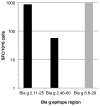Analysis of T cell responses to the major allergens from German cockroach: epitope specificity and relationship to IgE production
- PMID: 22706084
- PMCID: PMC3392449
- DOI: 10.4049/jimmunol.1200694
Analysis of T cell responses to the major allergens from German cockroach: epitope specificity and relationship to IgE production
Abstract
Bla g allergens are major targets of IgE responses associated with cockroach allergies. However, little is known about corresponding T cell responses, despite their potential involvement in immunopathology and the clinical efficacy of specific immunotherapy. Bioinformatic predictions of the capacity of Bla g 1, 2, 4, 5, 6, and 7 peptides to bind HLA-DR, -DP, and -DQ molecules, and PBMC responses from 30 allergic donors, identified 25 T cell epitopes. Five immunodominant epitopes accounted for more than half of the response. Bla g 5, the most dominant allergen, accounted for 65% of the response, and Bla g 6 accounted for 20%. Bla g 5 induced both IL-5 and IFN-γ responses, whereas Bla g 6 induced mostly IL-5, and, conversely, Bla g 2 induced only IFN-γ. Thus, responses to allergens within a source are independently regulated, suggesting a critical role for the allergen itself, and not extraneous stimulation from other allergens or copresented immunomodulators. In comparing Ab with T cell responses for several donor/allergen combinations, we detected IgE titers in the absence of detectable T cell responses, suggesting that unlinked T cell-B cell help might support development of IgE responses. Finally, specific immunotherapy resulted in IL-5 down modulation, which was not associated with development of IFN-γ or IL-10 responses to any of the Bla g-derived peptides. In summary, the characteristics of T cell responses to Bla g allergens appear uncorrelated with IgE responses. Monitoring these responses may therefore yield important information relevant to understanding cockroach allergies and their treatment.
Figures



Similar articles
-
Antigenic Determinants of the Bilobal Cockroach Allergen Bla g 2.J Biol Chem. 2016 Jan 29;291(5):2288-301. doi: 10.1074/jbc.M115.702324. Epub 2015 Dec 7. J Biol Chem. 2016. PMID: 26644466 Free PMC article.
-
IgE-binding epitope analysis of Bla g 5, the German cockroach allergen.Protein Pept Lett. 2010 May;17(5):573-7. doi: 10.2174/092986610791112765. Protein Pept Lett. 2010. PMID: 20044919
-
Different Bla-g T cell antigens dominate responses in asthma versus rhinitis subjects.Clin Exp Allergy. 2015 Dec;45(12):1856-67. doi: 10.1111/cea.12643. Clin Exp Allergy. 2015. PMID: 26414909 Free PMC article.
-
Allergen dose dependent cytokine production regulates specific IgE and IgG antibody production.Adv Exp Med Biol. 1996;409:295-303. doi: 10.1007/978-1-4615-5855-2_42. Adv Exp Med Biol. 1996. PMID: 9095257 Review.
-
Common food allergens and their IgE-binding epitopes.Allergol Int. 2015 Oct;64(4):332-43. doi: 10.1016/j.alit.2015.06.009. Epub 2015 Jul 29. Allergol Int. 2015. PMID: 26433529 Review.
Cited by
-
The identification of potentially pathogenic and therapeutic epitopes from common human allergens.Ann Allergy Asthma Immunol. 2013 Jan;110(1):7-10. doi: 10.1016/j.anai.2012.10.015. Epub 2012 Nov 15. Ann Allergy Asthma Immunol. 2013. PMID: 23244651 Free PMC article. Review.
-
Computational prediction of allergenic proteins based on multi-feature fusion.Front Genet. 2023 Oct 19;14:1294159. doi: 10.3389/fgene.2023.1294159. eCollection 2023. Front Genet. 2023. PMID: 37928245 Free PMC article.
-
Antigenic Determinants of the Bilobal Cockroach Allergen Bla g 2.J Biol Chem. 2016 Jan 29;291(5):2288-301. doi: 10.1074/jbc.M115.702324. Epub 2015 Dec 7. J Biol Chem. 2016. PMID: 26644466 Free PMC article.
-
Current insights into the genetics of food allergy.J Allergy Clin Immunol. 2021 Jan;147(1):15-28. doi: 10.1016/j.jaci.2020.10.039. Epub 2021 Jan 5. J Allergy Clin Immunol. 2021. PMID: 33436162 Free PMC article. Review.
-
Predictive in silico binding algorithms reveal HLA specificities and autoallergen peptides associated with atopic dermatitis.Arch Dermatol Res. 2020 Nov;312(9):647-656. doi: 10.1007/s00403-020-02059-0. Epub 2020 Mar 9. Arch Dermatol Res. 2020. PMID: 32152724 Free PMC article.
References
-
- Arshad SH. Indoor allergen exposure in the development of allergy and asthma. Current allergy and asthma reports. 2003;3:115–120. - PubMed
-
- Litonjua AA, V, Carey J, Burge HA, Weiss ST, Gold DR. Exposure to cockroach allergen in the home is associated with incident doctor-diagnosed asthma and recurrent wheezing. The Journal of allergy and clinical immunology. 2001;107:41–47. - PubMed
-
- Rosenstreich DL, Eggleston P, Kattan M, Baker D, Slavin RG, Gergen P, Mitchell H, McNiff-Mortimer K, Lynn H, Ownby D, Malveaux F. The role of cockroach allergy and exposure to cockroach allergen in causing morbidity among inner-city children with asthma. The New England journal of medicine. 1997;336:1356–1363. - PubMed
-
- Arruda LK, Vailes LD, Ferriani VP, Santos AB, Pomes A, Chapman MD. Cockroach allergens and asthma. The Journal of allergy and clinical immunology. 2001;107:419–428. - PubMed
-
- Gruchalla RS, Pongracic J, Plaut M, Evans R, 3rd, Visness CM, Walter M, Crain EF, Kattan M, Morgan WJ, Steinbach S, Stout J, Malindzak G, Smartt E, Mitchell H. Inner City Asthma Study: relationships among sensitivity, allergen exposure, and asthma morbidity. The Journal of allergy and clinical immunology. 2005;115:478–485. - PubMed
Publication types
MeSH terms
Substances
Grants and funding
LinkOut - more resources
Full Text Sources
Other Literature Sources
Research Materials

